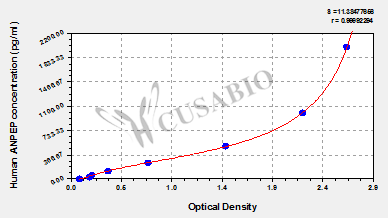The Human alanyl (membrane) aminopeptidase (ANPEP) ELISA kit is a reliable and efficient tool for the quantitative detection of Aminopeptidase N (AP-N), also known as hAPN or CD13, in serum, plasma, and tissue homogenates from Homo sapiens (Human) samples.
The ANPEP ELISA kit offers a broad detection range of 31.25 pg/mL to 2000 pg/mL and an impressive sensitivity of 7.81 pg/mL, enabling accurate and precise quantification of AP-N levels in your samples. The assay time is short, ranging from 1 to 5 hours, and requires only a small sample volume of 50-100ul.
The assay principle is a sandwich method, where the AP-N in the sample is captured by a coated antibody and detected by a biotinylated detection antibody, followed by a streptavidin-HRP conjugate, and finally, substrate solution. The signal is detected at a wavelength of 450 nm.






